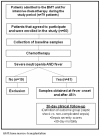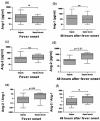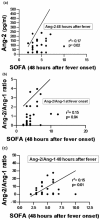Imbalances in serum angiopoietin concentrations are early predictors of septic shock development in patients with post chemotherapy febrile neutropenia
- PMID: 20509945
- PMCID: PMC2890004
- DOI: 10.1186/1471-2334-10-143
Imbalances in serum angiopoietin concentrations are early predictors of septic shock development in patients with post chemotherapy febrile neutropenia
Abstract
Background: Febrile neutropenia carries a high risk of sepsis complications, and the identification of biomarkers capable to identify high risk patients is a great challenge. Angiopoietins (Ang -) are cytokines involved in the control microvascular permeability. It is accepted that Ang-1 expression maintains endothelial barrier integrity, and that Ang-2 acts as an antagonizing cytokine with barrier-disrupting functions in inflammatory situations. Ang-2 levels have been recently correlated with sepsis mortality in intensive care units.
Methods: We prospectively evaluated concentrations of Ang-1 and Ang-2 at different time-points during febrile neutropenia, and explored the diagnostic accuracy of these mediators as potential predictors of poor outcome in this clinical setting before the development of sepsis complications.
Results: Patients that evolved with septic shock (n = 10) presented higher levels of Ang-2 measured 48 hours after fever onset, and of the Ang-2/Ang-1 ratio at the time of fever onset compared to patients with non-complicated sepsis (n = 31). These levels correlated with sepsis severity scores.
Conclusions: Our data suggest that imbalances in the concentrations of Ang-1 and Ang-2 are independent and early markers of the risk of developing septic shock and of sepsis mortality in febrile neutropenia, and larger studies are warranted to validate their clinical usefulness. Therapeutic strategies that manipulate this Ang-2/Ang-1 imbalance can potentially offer new and promising treatments for sepsis in febrile neutropenia.
Figures




Similar articles
-
Time-course of sFlt-1 and VEGF-A release in neutropenic patients with sepsis and septic shock: a prospective study.J Transl Med. 2011 Mar 3;9:23. doi: 10.1186/1479-5876-9-23. J Transl Med. 2011. PMID: 21371321 Free PMC article.
-
A tale of two ligands: angiopoietins, the endothelium, and outcomes.Crit Care. 2013 Oct 16;17(5):1007. doi: 10.1186/cc13066. Crit Care. 2013. PMID: 24131798 Free PMC article.
-
A high angiopoietin-2/angiopoietin-1 ratio is associated with a high risk of septic shock in patients with febrile neutropenia.Crit Care. 2013 Aug 5;17(4):R169. doi: 10.1186/cc12848. Crit Care. 2013. PMID: 23915833 Free PMC article.
-
Bacterial lung sepsis in patients with febrile neutropenia.Curr Opin Pulm Med. 2012 May;18(3):175-80. doi: 10.1097/MCP.0b013e328351f8e8. Curr Opin Pulm Med. 2012. PMID: 22343426 Review.
-
Nursing Care of Oncology Patients with Sepsis.Semin Oncol Nurs. 2021 Apr;37(2):151130. doi: 10.1016/j.soncn.2021.151130. Epub 2021 Mar 13. Semin Oncol Nurs. 2021. PMID: 33722431 Review.
Cited by
-
Time-course of sFlt-1 and VEGF-A release in neutropenic patients with sepsis and septic shock: a prospective study.J Transl Med. 2011 Mar 3;9:23. doi: 10.1186/1479-5876-9-23. J Transl Med. 2011. PMID: 21371321 Free PMC article.
-
Angiopoietin 2 mediates microvascular and hemodynamic alterations in sepsis.J Clin Invest. 2013 Jul 1;123(8):3436-45. doi: 10.1172/JCI66549. Online ahead of print. J Clin Invest. 2013. PMID: 23863629 Free PMC article.
-
Dysregulation of the angiopoietin-Tie-2 axis in sepsis and ARDS.Virulence. 2013 Aug 15;4(6):517-24. doi: 10.4161/viru.24906. Epub 2013 May 7. Virulence. 2013. PMID: 23652985 Free PMC article. Review.
-
Prognostic significance of the angiopoietin-2/angiopoietin-1 and angiopoietin-1/Tie-2 ratios for early sepsis in an emergency department.Crit Care. 2015 Oct 14;19:367. doi: 10.1186/s13054-015-1075-6. Crit Care. 2015. PMID: 26463042 Free PMC article.
-
A tale of two ligands: angiopoietins, the endothelium, and outcomes.Crit Care. 2013 Oct 16;17(5):1007. doi: 10.1186/cc13066. Crit Care. 2013. PMID: 24131798 Free PMC article.
References
-
- Bone RC, Balk RA, Cerra FB, Dellinger RP, Fein AM, Knaus WA, Schein RM, Sibbald WJ. Definitions for sepsis and organ failure and guidelines for the use of innovative therapies in sepsis. The ACCP/SCCM Consensus Conference Committee. American College of Chest Physicians/Society of Critical Care Medicine. Chest. 1992;101(6):1644–1655. doi: 10.1378/chest.101.6.1644. - DOI - PubMed
Publication types
MeSH terms
Substances
LinkOut - more resources
Full Text Sources
Other Literature Sources
Medical
Miscellaneous

